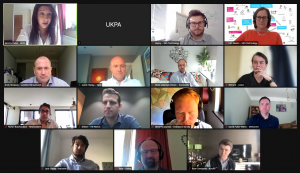Introduction
The UK Government is hoping to increase GDP by 2.8% through an increased focus on productivity. Technology has been, by necessity, at the forefront of a productive economy during the pandemic, and it will continue to be integral to recovery.
Smart technologies in infrastructure, as well as hardware and software applications that improve space optimisation, building management and tenant experience, have helped to reduce the cost of operations and increase worker productivity and wellbeing.
 The Roundtable involved delegates from across the spectrum of smart technology adoption who hoped to share their experiences and learn from others as to how and where to increase the use of technology to maximise productivity. The adoption of smart building automation is helping these companies to turn their portfolios into dynamic ecosystems of connected assets.
The Roundtable involved delegates from across the spectrum of smart technology adoption who hoped to share their experiences and learn from others as to how and where to increase the use of technology to maximise productivity. The adoption of smart building automation is helping these companies to turn their portfolios into dynamic ecosystems of connected assets.
Sustainability
Sustainability and meeting certain certification criteria such as ESG and EPC are priorities for landlords and tenants, particularly in a post-pandemic environment. The movement to more sustainable buildings through technology has already begun. In the US, for example, Yardi Pulse is an automated energy management system that can be installed across an entire building portfolio, providing analysis in ways of reducing costs and improving tenant comfort.
This highlights that stakeholders from across the industry have the motivation, financially and ethically, to create and utilise technology that can help create greener buildings, and that the implementation of these technologies can have a clear benefit to a modern society.
Trust
Delegates also mentioned trust as a key component of the evolving relationship between tenant and landlord.
Landlords need to be open and communicative with tenants regarding key demands such as sustainability, building amenities and data usage, and occupiers are seeking more eco-friendly environments and desire a holistic user experience that improves employee wellbeing and productivity.
Many delegates believe that technology such as tenant engagement applications and improving amenities are the ways to meet these demands and improve client retention and productivity. This is especially important in the office sector as we move towards a flexible approach to working and shorter leases, driven by the pandemic.
However, the responsibility for productivity does not only fall into landlords’ hands. There is an impetus amongst office tenants to install and manage technology themselves as it is easier to target and track employee productivity within a company’s own ecosystem. Independence of tenants’ technology allows landlords to focus on the financial and overall performance of a building, which will in turn increase tenant experience and engagement.
Challenges
Technology raises security and privacy issues. For Unloc, a PropTech company specialising in digital keys, the issue of security is crucial. If a smart building is hacked, it may be rendered unusable for a time, affecting productivity and client wellbeing.
Moreover, the data gathered from these technologies must be used ethically and with transparency, or trust between client and landlord will be lost. Landlord Broadband, a company who provides managed internet services for multiple occupancy properties, is at the centre of this issue as the data collected through its systems can be collected from a variety of a symbiotic and evolving client bases.
Many understand the benefits of using smart building technology, but time and resources may be wasted unnecessarily without a direct, specific purpose. Technology must correlate with ROI for it to be seen as viable, and many companies are holding back on implementing technology until it has been tried and tested by others. Smart technology such as Retransforms Valere accounting product can combine the financial aspects of smart technology with real time insights into how they improve productivity and efficient property management.
There is also a lack of an industry wide productivity measurement system. Retail tenants can measure productivity in sales per square feet, but this does not easily apply to other commercial real estate users.
Other challenges such as generational divides, the over-engineering of tech solutions and budgeting were mentioned as obstacles that need to be overcome in order to drive the adoption of technology and create smart buildings.
Conclusion
Data and technology can be used to improve the productivity of both buildings and its occupiers, when there is a purposeful and clear strategy. Smart technology is particularly improving productivity in sustainability practices and is beginning to connect providers with their users to enhance their collaboration, wellbeing and experience, all of which will increase productivity and help the industry on its way to aiding recovery. The smoother, simpler and more collaborative technology becomes today, the better the chances of a more productive tomorrow.
Delegate List
Jack Sibley – Head of Partnerships at Insurami
Terje Skog Jenssen – Head of Sales at Unloc
Richard Senger – Business Consultant at Unloc
Ryan Dempster – Architect at Knotel
Danny Hayter – Head of Partnerships at 345 Technology
Kim Mason – Head of Marketing at 345 Technology
Andrew Simpson – Managing Director at Landlord Broadband
Justin Harley – Regional Director at Yardi
Rohan Bulchandani – Founder of Retransform
Gilbert Lennox-King – Symbiosy Sales Director at HB Reavis
Chris Coleman-Brown – Director at Cureoscity
Latest News
How AI and Technology is Transforming the Property Market
By Callum Board Global Client Success Director at REdirect Consulting Technology and digital solutions have grown to become an integral part of our everyday ...
Spotlight Interview : Trustek
In our latest spotlight interview, we spoke to Trustek Co- Founders; Freddie Pritchard-Smith and Michael Crawford. Freddie & Michael shed light on the Verified Marketplace, helping clients navigate the PropTech marketplace ...
Spotlight Interview : Etainabl
In our latest spotlight interview, we spoke to Ben Perrett, Co-Founder & Director at Etainabl. Ben shares their journey so far, how they ensure data ...